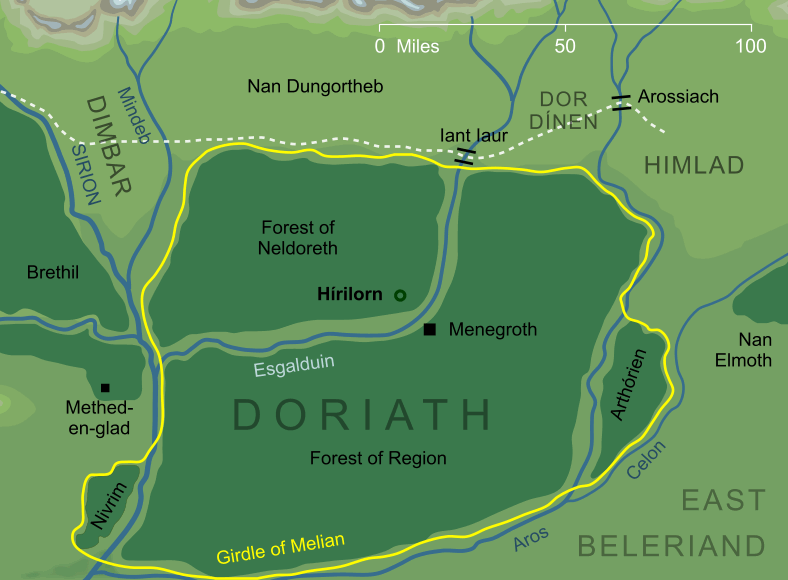
The approximate location of Hírilorn within
Doriath3
The approximate location of Hírilorn within
Doriath3An immense beech-tree that grew close to the gates of Menegroth, the underground capital of King Thingol. Its original name seems to have been Neldor, meaning 'triple-tree' because of its three tall straight trunks. It is a mark of the tree's fame that its name ultimately became the Sindarin word for 'beech', from which was named the entire forest of Neldoreth, where it grew.
Its name was changed at the time of the Quest of the Silmaril. Concerned that his daughter Lúthien would risk danger seeking out Beren, Thingol had a house built among the branches of the great beech, and imprisoned Lúthien there. After this time the tree's name was changed to Hírilorn, meaning 'Tree of the Lady', though it did not hold Lúthien for long. Using her magical arts, she escaped from Hírilorn and set out to aid Beren in many adventures, eventually helping him to recover a Silmaril from Morgoth's Iron Crown.
As it had seen these first steps in the Quest, the mighty beech also saw its end: the Silmaril was finally recovered in the Hunting of the Wolf, but in that hunt Beren received a mortal wound, and it was beneath Hírilorn's branches that Lúthien was briefly reunited with him before he died.
Notes
1 |
We have no real clues to the dating of Hírilorn, except that it was clearly ancient even at the time of the Quest for the Silmaril. Beech trees can live for centuries (or even millennia under the right circumstances) so it might quite possibly have survived to the end of the First Age, about a hundred years after the Quest. It would ultimately have met its end, along with most of Beleriand, in the cataclysms that accompanied the War of Wrath.
|
2 |
According to The Etymologies (in volume V of The History of Middle-earth), the 'proper' name of the tree was Neldor, thought to derive from Elvish words for 'three' and 'tree' (because it was formed from three trunks growing together). From this neldor became the general word for a beech in Doriath, hence the forest name Neldoreth.
|
3 |
We have no map showing Hírilorn's precise location, but we do have two significant facts that help to narrow that location down: that it lay close to Menegroth, and that it stood within the Forest of Neldoreth. Menegroth was not in Neldoreth but in neighbouring Region, on the river Esgalduin that separated the two forests. So, Hírilorn must have been across the river from Thingol's stronghold. For the tree to be near Menegroth, it must have stood somewhere in the crook of Esgalduin, where the course of the river curved round from a southward direction to flow westward toward Sirion.
|
Indexes:
About this entry:
- Updated 12 February 2022
- This entry is complete
For acknowledgements and references, see the Disclaimer & Bibliography page.
Original content © copyright Mark Fisher 2003, 2021-2022. All rights reserved. For conditions of reuse, see the Site FAQ.

